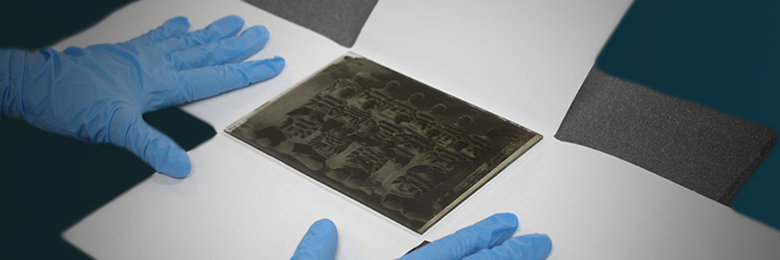Cultural heritage collections provide invaluable information relating to our past and it is essential that institutions carefully consider how to protect them. Preventative conservation (correct storage, archival packaging, and proper handling) helps ensure the longevity of these precious materials – but what measures should be taken to protect collections in the event of a disaster?
This has been a progressively important topic for museums and other cultural heritage institutions to consider, especially with the increasing frequency of extreme weather heightening the likelihood of devastating floods or fires — such as those experienced recently in Australia. The 2011 Christchurch earthquake also set in motion a drive for disaster preparation, especially within New Zealand institutions that witnessed the consequences first-hand. The Canterbury Disaster Salvage Team, a voluntary organisation founded in 1987, provides advice and regular training for people within the GLAM sector, helping to mitigate potential risks and ensure appropriate measures are in place to protect cultural heritage collections.
Recently, the Covid-19 pandemic highlighted just how vulnerable cultural heritage institutions are to global disasters. These institutions faced a range of tough decisions in the fight against coronavirus such as closing their doors to the public, severely reducing services, and staff redundancies. In response to these unprecedented events, alternative means of community engagement was explored by institutions like moving collections online and offering virtual tours. The global health crisis has been disrupting both to the communities wanting access to cultural heritage collections and to the people caring for them. The GLAM sector plays a vital role in our society as community hubs, informal learning environments, and protectors of our cultural heritage — so, it is essential that we put measures in place to ensure their longevity.
The following resource briefly outlines how cultural heritage institutions might plan for disasters and how they can recover in the aftermath of a fire, flood, or earthquake.

Contingency Plans
Cultural heritage institutions need to be prepared for disasters and emergencies: at least one museum in New Zealand each year is hit by a disaster and will need to salvage its collections. Creating a contingency plan is one way that institutions can prevent a disaster from turning into a tragedy. The Museum of New Zealand Te Papa Tongarewa has some excellent resources that can help you create disaster and emergency contingency plans for your institution. A good plan will detail how staff should react to several disaster scenarios, how these situations should be handled, the rescue or salvage priorities, and how the institution might recover.
When developing a plan, institutions will need to consider questions like:
- How stable is the ground under the museum?
- Are valuable collections extensively photographed or digitised and insured?
- Is there a regular building maintenance schedule?
- Are water pipes protected from corrosion or damage from frost?
- Can collections be stored temporarily off-site if the building is compromised?
- Have all collections been assessed and catalogued to aid potential recovery operations?
- Are there local facilities available that can prevent further damage (e.g., cool stores)?
- Are any pests common to the area? What are other environmental concerns?
- Have you established which items have the greatest priority?
- Who will take on certain roles during the recovery efforts, including external assistants and volunteers?
Steps for disaster recovery should also be detailed within your contingency plan – however, it is very important to keep staff out of the building until emergency services have deemed it safe.
Always seek advice from conservation professionals before beginning a recovery operation as handling and treatment of different materials can vary wildly. After a disaster, objects should be removed from the scene in a sequence that limits further damage. For example, begin by removing objects that are on the floor, then rescue those that will need immediate professional treatment like photographic prints.
Photographic evidence of any damage is needed to support insurance claims as well as a detailed list of destroyed, damaged, or missing objects. Make sure that recovered objects are checked off against your institution’s inventories.
Having disaster recovery supplies readily available is an essential component of a disaster preparation plan. These supplies might include plastic sheeting, a torch with batteries, heavy-duty gloves, a large bucket to catch water, scissors, tape, water-soaking pads, and towels.
Digitisation is another preservation measure your institution should consider to ensure collections are protected in a disaster. Valuable objects will be preserved in a digital format even if the original is destroyed.

Fire
In 2018 the National Museum of Brazil in Rio de Janeiro suffered a catastrophic disaster, it was engulfed by a fire that raged for more than five hours. Almost completely gutting the 200-year-old building, the fire destroyed countless objects housed in the museum including irreplaceable frescoes from Pompeii, an ancient Egyptian painted sarcophagus, indigenous Brazilian artwork, and an entire collection of entomological specimens that once boasted twice as many as the British Museum. The loss of this museum, and all that it contained, was devastating to both national and international communities — and it was preventable. The museum’s infrastructure was badly in need of renovation: it had been prone to leaks, insect infestations, and crucially there was no sprinkler system that could have helped to contain the fire.
After a fire, collections will be charred and brittle from exposure to extreme heat, covered in ash, smell of smoke, soggy from the water used to extinguish the fire, and will likely develop mould. It can be incredibly difficult for a cultural heritage institution to recover from a fire, so prevention is key.
Fire prevention measures:
- Be vigilant about turning off appliances or heaters and watch out for any indication of electrical damage.
- Have appropriate fire extinguishers readily available and train staff to use them effectively. Different extinguishers are required for different materials.
- Make copies of important documents, such as museum records and insurance policies, and keep a copy off-site.
- Regularly check smoke alarms and make sure they are fitted in every room.
- Invest in a sprinkler system.
Sprinkler systems are proven to be very effective, and while objects could suffer water damage, they can usually be salvaged. In the aftermath of a fire make sure you consult a conservation specialist before beginning any recovery procedures. Generally, the most valuable collections should be rescued first, followed by the ones that have suffered the most damage. Burnt and wet materials will need to be handled very carefully as they will be extremely fragile. They should be supported by a tray or trolley to limit further damage before being transported to a safe location for evaluation or conservation.

Flood
Unfortunately, water damage is a common problem for cultural heritage institutions. Floods can be caused by weather events, mechanical failures, building problems, and technological hazards. Even a small leak can eventually destroy a collection or could worsen into a catastrophic flood. Many institutions underestimate the likelihood of these disasters happening — but minimising the risk of a flood is easy to accomplish.
Flood prevention measures:
- Keep objects elevated whilst on display or in storage
- Never leave boxes of material or objects on the floor, even temporarily.
- Store paper documents or photographs in waterproof boxes made from fluted polypropylene.
- Where possible, avoid displaying or storing objects in basement areas or under pipes. If this is not practical, ensure there is a waterproof barrier between the pipes and the objects.
- Develop a checklist to ensure the building is visually inspected regularly: check for roof leaks, leaking windows, and blocked eaves-troughs.
- Monitor and regularly document the relative humidity of collection stores. If there is a significant increase it can indicate excessive moisture before damage becomes irreversible.
- Have absorbent sponges and a pump on hand to remove water in case a flood occurs.
- When a bad storm is predicted place sandbags at windows and doors, cover objects with tarpaulins, and move collections to higher levels.
Again, consulting a conservation specialist should be your first port of call before attempting recovery efforts. Once all standing water has been drained away, reducing humidity and stabilising the air temperature with industrial fans and dehumidifiers should be the next objective to limit further damage to your collections. Mould begins to develop very quickly on wet materials – in 72 hours you will start to see signs of mould growing and once it has established it can be very difficult to eradicate. During the salvage operation, objects should be separated into four categories: dry, damp, slightly wet, and wet. This will assist in determining the extent of any remedial conservation objects require as well as ensuring undamaged objects are isolated.
In 2003 the storage facility for Cumberland Heritage Village Museum in Canada was flooded by a burst water-pipe. During one of the building’s regular inspections, staff discovered that over 2,000 m³ of water had leaked onto some of the objects housed inside.
The museum’s disaster prevention plan saved many of the objects housed in the storage facility. Small objects had been raised off the ground on metal racks and were covered with polyethylene sheeting reducing potential water damage. The building also had a central drain which stopped the water pooling, otherwise, it could have risen over a metre before the leak was discovered.
Large items, such as furniture and agricultural implements, did not fare so well and were completely saturated — wooden objects had warped, paint flaked off, and veneers began to separate. Mould is one of the biggest dangers to a water-damaged collection, fortunately, the museum had a plan in place to speed up the drying process and minimise mould growth. The relative humidity in the facility was reduced by 40% in less than a week by raising the large doors at both ends of the building and by placing a commercial-sized fan at one end to encourage air circulation. Paper materials were placed in clean boxes and then moved to a commercial freezer facility to be vacuum freeze-dried. The overall damage to the museum’s collection was not severe and this can be attributed to the quick assessment, drying, and stabilisation laid out in a disaster plan.

Earthquake
Earthquakes are one of the most unpredictable and difficult disaster situations to prepare for – they can occur at any time and without warning. Institutions must evaluate their location’s seismic risks and what measures can be put in place to limit damage if it occurs.
The earthquakes that devastated Christchurch during 2010 and 2011 exposed many cultural heritage institutions in the region to uncertainty and hardship – including Lyttelton Museum whose building was so severely damaged it needed to be demolished. Canterbury Museum was one of the oldest buildings left standing in the Christchurch CBD following the 6.2 magnitude earthquake on the 22nd February 2011. In part, this is down to the fact that the museum had already been aware of the earthquake risks faced by Christchurch and had planned for this sort of disaster — evident by the 10-year-long earthquake strengthening project completed in 1995.
Even though the earthquake destroyed a large selection of the city’s historic buildings, Canterbury Museum was declared structurally sound. The museum’s collections did not sustain significant damage either, with less than 1,000 objects destroyed out of the 15,000 on display. After the earthquake, an extensive assessment took place where every damaged object was photographed, itemised by location, and cross-referenced with insurance details.
Although it is impossible to know when an earthquake will take place, there are still many precautions that cultural heritage institutions can put in place to reduce damage.
Earthquake damage prevention measures include:
- Secure small objects with museum wax or putty. Note that the wax is not suitable for some materials e.g. it can damage porous items.
- Hang artwork from two hooks – if one hook dislodges during an earthquake, the other can hold the artwork’s weight and it will not fall to the ground. Some hanging fixtures can also be locked into place.
- Attach solid mounts to large objects.
- Keep mobile units in collection stores locked down unless in use.
A particularly innovative method to reduce earthquake damage to collections was developed by the Getty Museum. This invention isolates objects from the ground’s movement to prevent them from shattering during an earthquake. Large objects, like marble sculptures, are bolted to a base connected to the ground with three individual frames on rollers. The frames absorb and diffuse the earthquake’s shaking by sliding separately, while springs provide resistance and slow down any movement.
After an earthquake, broken objects should be carefully collected and placed into a zip-lock bag. Each object should be placed in a different bag and its pieces can be padded with tissue paper, so they do not sustain more damage. Remember to collect every piece of the object, no matter how small, to give it the best chance for later conservation.

Digitisation
Digitisation can play an important role in the preservation of cultural heritage collections, particularly in the aftermath of a disaster. Digitising a collection ensures that if the original object is damaged or has deteriorated, the information it held and contributed to cultural heritage is not lost. Digitised copies can also act as a surrogate for display purposes when the original is too fragile to handle or is vulnerable to damage.
While digitisation is an excellent preservation method, digital files must also be protected from disasters. It is important to have master files backed-up in at least two different places so that if one fails or corrupts, it is not completely lost. One of these places should be off-site, away from your institution, so that it will not be affected by widespread disaster. Uploading your digitised collections to a trusted online cloud-based platform, like Recollect, is another way to ensure your digitised collection is kept safe. It also allows your collection to continue to be fully accessible even when your institution is closed for long periods following a disaster.
An irreplaceable collection of over 200 Chinese Paper Gods can be found in The Starr East Asian Library at Columbia University. Originally intended to be burnt during religious ceremonies, these objects are ephemeral in nature — they are made of paper featuring a wood-cut print of a deity. This collection is incredibly fragile and cannot be handled without causing it damage. The Starr East Asian Library has digitised the collection to ensure that when the paper gods eventually deteriorate the information they contribute about Chinese cultural heritage will be preserved, both for research purposes and for the benefit of future generations.
Conclusion
Disasters can result from a range of factors including extreme weather events, technical or mechanical failures, and even lapses in building maintenance. All cultural heritage institutions can be affected by a disaster and should be prepared for multiple scenarios. A contingency plan is the first step to ensure your collections survive a fire, flood, or earthquake. A plan will help you evaluate the unique risks faced by your institution and what measures can be put in place to limit damage if it occurs. Digitising your collection is an important step towards a comprehensive disaster preparation plan because it guarantees the longevity of your collection even when original objects are destroyed. Our team at NZMS can assist you in this process by providing quality digitisation services.
References
- Canterbury Disaster Salvage Team. (2007). FAQs. [online] Available at: http://www.disalteam.co.nz/
- Catlin, Nora E. (2019). Protect your Art in Earthquakes. [online] Available at: https://marloweart.com/protect-your-art-in-earthquakes/
- Gertz, Jannet. (N.D). Preservation and Selection for Digitization. [online] Available at: https://www.nedcc.org/free-resources/preservation-leaflets/6.-reformatting/6.6-preservation-and-selection-for-digitization
- Lloyd, Jennifer. (2011). Disaster Preparedness at the National Library of Australia. [online] Available at: https://www.nla.gov.au/content/disaster-preparedness-at-the-national-library-of-australia
- Majewski, L.J., 1986. Preparedness for Natural Disasters for Monuments and Artifacts. In Protecting Historic Architecture and Museum Collections from Natural Disasters (pp. 343-346). Butterworth-Heinemann.
- Museum of New Zealand Te Papa Tongarewa (2001). ‘Emergency Procedures’. Te Papa National Services Resource Guides 7: 2001.
- Museum of New Zealand Te Papa Tongarewa (2001). ‘Minimising Disaster’. Te Papa National Services Resource Guides 6 : 2001.
- Museum of New Zealand Te Papa Tongarewa (2001). ‘Preventive Conservation’. Te Papa National Services Resource Guides 5: 2001.
- Museum of New Zealand Te Papa Tongarewa. (2019). Disaster planning and recovery. [online] Available at: https://www.tepapa.govt.nz/disaster-planning-and-recovery
- National Preservation Office. Collection salvage guidelines. [online] Available at: https://natlib.govt.nz/files/collectioncare/Collection-salvage-guidelines-sept-2010.pdf
- Ogden, Sherelyn. (N.D). Protection from Loss: Water and Fire Damage, Biological Agents, Theft, and Vandalism. [online] Available at: https://www.nedcc.org/free-resources/preservation-leaflets/3.-emergency-management/3.1-protection-from-loss-water-and-fire-damage,-biological-agents,-theft,-and-vandalism
- Palmer, G., 2014. Digitization, Can it Play a Role in Disaster Preparedness?. OLAQ, 14(4), p.20.
- Topham, Abbey L. (2017). Laying down foundations: reflecting on disaster management planning in museums in Christchurch after the 2010 and 2011 earthquakes. [online] Available at: https://ir.canterbury.ac.nz/handle/10092/15790
- Tremain, David. (2018). Agent of Deterioration: Water.
Available at: https://www.canada.ca/en/conservation-institute/services/agents-deterioration/water.html - Yong, Ed. (2018). What Was Lost in Brazil’s Devastating Museum Fire. [online] Available at: https://www.theatlantic.com/science/archive/2018/09/brazil-rio-de-janeiro-museum-fire/569299/
